Dry flower arrangements, also known as everlasting arrangements, involve using flowers that have been dried to create long-lasting and decorative displays. When creating dry flower arrangements, it’s important to choose flowers that naturally hold their shape, color, and texture when dried. These dried arrangements not only provide long-lasting beauty but also evoke a timeless and rustic charm.
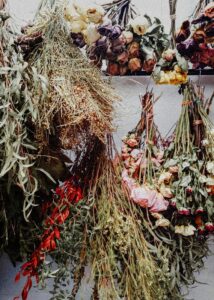
This ancient art form has gained popularity for its sustainable and long-lasting nature. Dry flower arrangements allow individuals to enjoy the beauty of flowers beyond their fresh bloom, as dried flowers retain their form, color, and texture for an extended period. The process involves harvesting flowers at their peak, drying them using various techniques, and arranging them in aesthetically pleasing compositions.
Dry flower arrangements promote sustainability by reducing the need for fresh flowers and minimizing waste. Dried flowers can be preserved for months or even years. Unlike fresh flowers, dried flowers require minimal maintenance. They do not need water, and their enduring beauty makes them ideal for individuals who prefer low-maintenance decor.
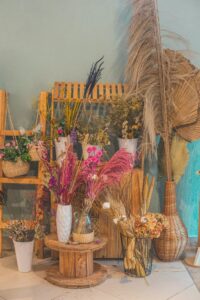
Whether used in vases, wreaths, bouquets, or other creative displays, dry flower arrangements offer a sustainable and artistic way to enjoy the beauty of flowers throughout the year. The enduring charm of dried flowers brings a timeless and natural element to interior decor.
Lavender Flowers Used for Dry Flower Arrangements
One of the primary reasons for using dried lavender in arrangements is its delightful and calming fragrance. The dried flowers continue to release a subtle lavender scent, adding a pleasant aroma to the arrangement. Dried lavender maintains its original color well, often showcasing hues ranging from shades of purple to gray. This color retention makes it visually appealing in dry arrangements.
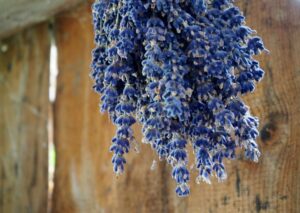
Lavender flowers have a distinctive and slender shape, contributing a unique texture to dry bouquets. The long stems with small, clustered blooms create a graceful and elegant appearance. Dried lavender is versatile and can be used in various types of arrangements, including bouquets, wreaths, and centerpieces. Its slender stems make it easy to incorporate into different designs.
Lavender’s timeless and classic appearance adds a touch of rustic charm to dry flower arrangements. It complements both traditional and contemporary styles, making it a versatile choice for various decor themes. Lavender can be combined with other dried flowers, grasses, and seed pods to create diverse and visually interesting arrangements. It pairs well with materials like dried roses, statice, or eucalyptus.
To use lavender in dry arrangements, it’s essential to harvest the flowers at the right stage—when they are fully developed but not overripe. Hang the lavender bundles upside down in a dark, dry, and well-ventilated space for drying.
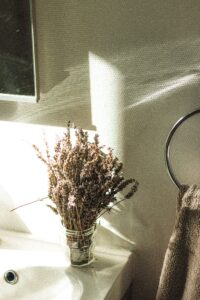
Whether used as a standalone element or combined with other dried flowers, lavender contributes to the overall beauty and fragrance of dry flower arrangements. Its enduring appeal and multiple uses make it a favored choice for those looking to incorporate natural and aromatic elements into their decor.
Statice Dry Flower
Statice (Limonium sinuatum), commonly known as sea lavender or statice flower, is a popular choice for dry flower arrangements due to its unique characteristics and ability to retain color and form when dried. This flowers come in a variety of colors, including shades of purple, blue, pink, white, and yellow. This wide color range allows for versatility in creating visually appealing and vibrant arrangements.
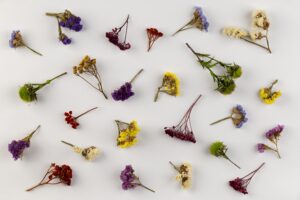
The flowers of statice have a papery texture, and the small, densely packed blooms are arranged in clusters on upright stems. The unique texture and form of statice add visual interest and depth to dry arrangements. One of the significant advantages of statice in dry arrangements is its ability to maintain its color and structure for an extended period. This makes it suitable for creating long-lasting and durable floral displays.
Statice is typically air-dried to preserve its color and form. Harvest the statice flowers when they are fully open but not overly mature. Hang them upside down in a cool, dark, and well-ventilated space for drying. Statice is versatile and can be used in various types of dry arrangements, including bouquets, wreaths, and dried flower crafts. It complements both traditional and contemporary decor styles. Due to its compact clusters and slender stems, statice works well as a filler in dry arrangements. It can be combined with other dried flowers, grasses, or seed pods to create balanced and harmonious compositions.
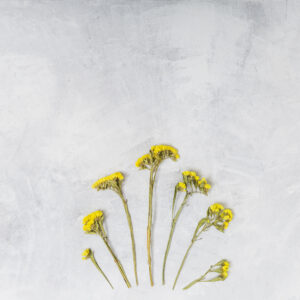
Gypsophila Flower used as a Dry Flowers
Gypsophila, commonly known as Baby’s Breath, is a popular flower used in dry flower arrangements due to its delicate appearance, airy texture, and ability to retain its form and color when dried. Baby’s breath flower is known for its fine and airy texture, with numerous small, delicate flowers on branching stems. This quality adds a light and ethereal feel to dry arrangements. When dried properly, Gypsophila retains its natural color, typically a light and neutral shade. This makes it suitable for creating arrangements with a soft and subtle color palette.
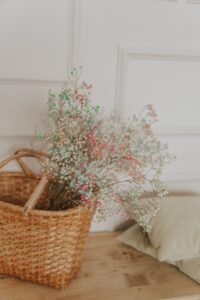
Baby’s Breath has a good shelf life when dried, making it a reliable choice for long-lasting dry flower arrangements. Its enduring quality ensures that the arrangement remains visually appealing over time. It pairs well with other dried flowers, herbs, or foliage to create balanced compositions.
Gypsophila is commonly air-dried to preserve its delicate structure. Harvest the stems when the flowers are fully open but not yet fully mature. Hang them upside down in a cool, dark, and well-ventilated space to dry. Baby’s Breath works well as a filler in dry arrangements, adding volume and enhancing the overall composition. It can be used to accentuate focal flowers or create a soft backdrop for other dried elements. The neutral color and delicate appearance of Gypsophila make it suitable for a variety of decor styles. It complements both rustic and elegant aesthetics, adding a touch of grace to the arrangement.
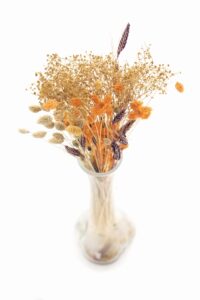
Strawflowers in Dry Flower Bouquet
One of the distinctive features of Strawflower is its papery texture. The flower heads have a dry and crisp feel, resembling straw, which adds a unique element to dry arrangements. Strawflower comes in a variety of vibrant colors, including shades of red, orange, yellow, pink, and white. The intense and long-lasting colors make it an attractive choice for creating visually striking arrangements. Its ability to maintain color and form adds durability to the overall composition.
Strawflower is commonly air-dried to preserve its papery texture and vibrant colors. Harvest the flowers when they are fully open but not overly mature. Hang them upside down in a dark, dry, and well-ventilated space for drying.

The unique texture of Strawflower, combined with its sturdy stem structure, makes it an excellent choice for providing both visual and tactile interest in dry arrangements. It holds its shape well, adding structure to bouquets. Due to its vivid colors and long-lasting nature, Strawflower is commonly used in seasonal decor, such as fall wreaths, harvest arrangements, or festive crafts.
Sunflower Used in Dry Flower Arrangements
Sunflowers can be used as dried flowers in dry flower arrangements, bringing a touch of warmth and rustic charm to the display. Harvest sunflowers when they are fully mature but before the seeds are completely dry. Cut the stems and remove excess leaves. Hang them upside down in a dry, dark, and well-ventilated area to air-dry. The petals and seed heads will maintain their form during the drying process.
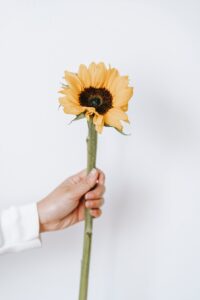
Dried sunflowers retain much of their natural appearance, including the distinctive dark center (seed head) and golden petals. The dried petals may have a slightly different color than fresh ones, but they still exude the sunflower’s characteristic warmth. Dried sunflowers add a unique texture to arrangements with their large and sturdy seed heads. The size and presence of these flowers make them suitable for creating focal points or statement pieces in dry arrangements.
Dried sunflowers are ideal for seasonal decor, especially in fall-themed arrangements. They can be incorporated into wreaths, garlands, or other displays that evoke the warmth and colors of autumn. The natural, rustic charm of sunflowers makes them a timeless choice for dry flower arrangements. They bring a touch of the outdoors and a sense of the harvest season to interior spaces.
Yarrow Flower in Dry Flower Arrangements
Yarrow (Achillea millefolium) is a versatile herbaceous plant whose dried flowers are often used in dry flower arrangements. Harvest yarrow flowers when they are in full bloom, cutting the stems with clean, sharp scissors. To dry yarrow, hang the stems upside down in a dark, dry, and well-ventilated area. The flowers will retain their shape and color during the drying process.
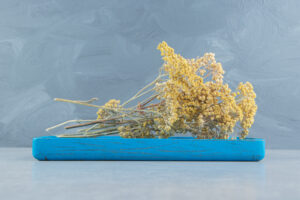
Dried yarrow flowers maintain much of their natural appearance, with feathery clusters of small blooms in various colors, including white, yellow, pink, or lavender. The dried flowers often have an earthy and rustic charm. Yarrow adds a unique texture and structure to dry arrangements with its finely divided leaves and small, tightly packed flowers. The feathery appearance of the blooms creates an airy and delicate quality. Yarrow’s natural and wild aesthetic makes it a popular choice for arrangements with a more relaxed and informal feel. It adds a touch of the outdoors and the meadow to interior spaces.
Rose Flower Used in Dry Flower Arrangements
Roses (Rosa spp.) are classic and timeless flowers that are also used in dry flower arrangements. Harvest roses when they are fully open but before they begin to wilt. Cut the stems with clean, sharp scissors or pruning shears. To dry roses, hang them upside down in a dark, dry, and well-ventilated space. Drying preserves their form and color.
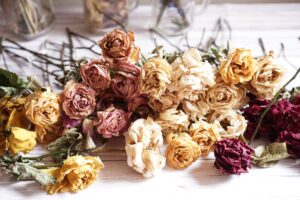
Dried roses come in a variety of colors, allowing for a range of possibilities in creating arrangements with different color schemes. The dried petals often maintain their original hues, providing a rich and elegant appearance. Dried rose flowers bring a classic and sophisticated touch to dry arrangements, making them suitable for various occasions, including weddings and formal events.
Dried rose flowers maintain their texture and structure, including the softness of the petals and the unique shape of each bloom. Their intricate form adds a touch of delicacy and refinement to arrangements. Their enduring beauty ensures that the arrangement remains visually appealing over time.

Including dried roses in arrangements can convey these symbolic messages, adding depth and significance to the display. While the fragrance of dried roses is not as potent as fresh ones, they may still retain a subtle scent. This adds a sensory element to arrangements, enhancing the overall experience.
Globe Amaranth Used in Dry Flower Arrangements
Gomphrena (Gomphrena globosa), commonly known as globe amaranth or bachelor’s button, is a popular flower that can be used in dry flower arrangements. Harvest gomphrena flowers when they are fully open and at their peak freshness. To dry them, hang the stems upside down in a dark, dry, and well-ventilated space. Drying preserves the vibrant colors and unique spherical shape of the flower heads.
Dried gomphrena flowers maintain their intense and vibrant colors, which can range from shades of pink, purple, magenta, to white. This long-lasting color makes them an attractive choice for dry flower arrangements. The distinctive globe-shaped flower heads of gomphrena add a unique and interesting element to dry arrangements.
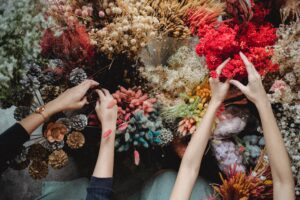
Dried gomphrena is versatile and can be used in different types of dry arrangements, such as bouquets, wreaths, and centerpieces. They pair well with other dried flowers, grasses, or seed pods, offering creative possibilities for textured compositions. Gomphrena flowers maintain their texture and structure when dried. The small, round bracts that make up the flower heads create a visually interesting and textured surface, contributing to the overall appeal of the arrangements.
Celosia Flower Used in Dry Flower Arrangements
Celosia, also known as cockscomb or woolflower, is a flowering plant that can be dried and used in dry flower arrangements. Harvest celosia flowers when they are fully open and at their peak bloom. To dry them, hang the flower heads upside down in a dark, dry, and well-ventilated space. Drying preserves the unique shape and texture of the flowers.
Celosia flowers are known for their distinctive shape, often resembling a cockscomb or plume. When dried, they retain this unique form, adding a touch of drama and visual interest to dry arrangements. The texture of dried celosia is often velvety and soft. Celosia flowers come in a range of vibrant colors, including red, orange, pink, and burgundy. The dried flowers maintain their color, making them a lively and eye-catching addition to dry flower compositions.
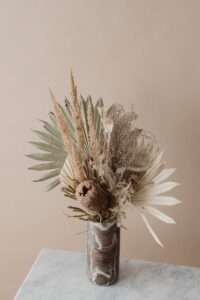
Dried celosia is versatile and can be used in various types of dry arrangements, such as bouquets, wreaths, and centerpieces. Its distinctive appearance allows it to stand out or complement other dried flowers and foliage in creative designs. Properly dried celosia flowers have good longevity, making them suitable for long-lasting dry flower arrangements. Dried celosia requires minimal maintenance, making it an excellent choice for those who prefer arrangements that do not need regular care.
Poppy Flower Seed Heads are used in Dry Flower Arrangements
Using poppy flower seed heads in dry flower arrangements can add unique and interesting elements to your decor. Wait until the poppy flowers have bloomed and the petals have fallen off, leaving behind the seed heads. Harvest the seed heads on a dry day when the seeds inside are mature. Cut the stems with a sharp pair of scissors or pruning shears.

Hang the harvested poppy seed heads upside down in a dark, dry, and well-ventilated space. This allows the seeds to mature further and the seed heads to dry naturally. Ensure that the seed heads are not exposed to direct sunlight during the drying process to prevent color fading. While poppy seed heads may not retain vibrant colors like some dried flowers, they often develop interesting textures and earthy tones.
Once dried, poppy seed heads can be used in various decorative arrangements. They work well in rustic or natural-themed arrangements and can be combined with other dried flowers, grasses, or foliage. Place dried poppy seed heads in vases, jars, or containers as standalone decor pieces. They can be a subtle yet intriguing addition to your home, particularly in spaces with natural or rustic aesthetics.
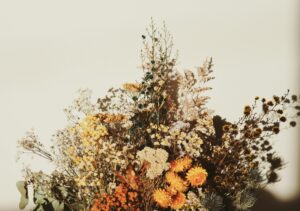
In summary, incorporating dry flower arrangements into your home provides a sustainable, cost-effective, and aesthetically pleasing way to enjoy the beauty of flowers while minimizing maintenance efforts. Their versatility and long-lasting qualities make them a valuable addition to home decor.


